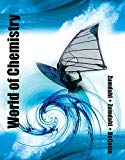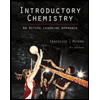
Mastering Chemistry with Pearson eText -- Standalone Access Card -- for Introductory Chemistry (6th Edition)
6th Edition
ISBN: 9780134565927
Author: Nivaldo J. Tro
Publisher: PEARSON
expand_more
expand_more
format_list_bulleted
Concept explainers
Textbook Question
Chapter 5, Problem 82E
Write a formula for each acid.
a. hydrofluoric acid
b. hydrocyanic acid
c. chlorous acid
Expert Solution & Answer
Want to see the full answer?
Check out a sample textbook solution
Students have asked these similar questions
Pls help me on this q.
Given the elementary reactions in an aqueous medium with an ionic strength of 0.001:1) CH3Br + OH- → CH3OH + Br-2) ClCH2COO- + OH- → HOCH2COO- + Cl-3) [Co(NH3)5Br]2+ + NO2- →[Co(NH3)5NO2]2+ + Br-If the ionic strength is decreased, 1) k will not change; 2) k will decrease; and 3) k will increase. Is this correct?
Relate zero ionic strength and infinite dilution limit.
Chapter 5 Solutions
Mastering Chemistry with Pearson eText -- Standalone Access Card -- for Introductory Chemistry (6th Edition)
Ch. 5 - Q1. Carbon tetrachloride has a chlorine - to-...Ch. 5 - Write a chemical formula for a compound that...Ch. 5 - Q3. How many oxygen atoms are in the chemical...Ch. 5 - Which element is a molecular element? a. Copper b....Ch. 5 - Q5. Which compound is ionic?
a.
b.
c.
d.
Ch. 5 - Write a formula for the compound that forms...Ch. 5 - Prob. 7SAQCh. 5 - Prob. 8SAQCh. 5 - Name the compound CrCl3 a. monochromium...Ch. 5 - Name the compound BaSO4 a. barium sulfate b....
Ch. 5 - Name the compound PF5. a. monophosphorus...Ch. 5 - Q12. What is the formula for manganese (III)...Ch. 5 - Q13. Name the acid (aq).
a. hydrogen phosphate
b....Ch. 5 - What is the formula for hydrobromic acid? a. HBr...Ch. 5 - Prob. 15SAQCh. 5 - 1. Do the properties of an element change when it...Ch. 5 - How might the world be different if elements did...Ch. 5 - What is the law of constant composition? Who...Ch. 5 - 4. What is a chemical formula? List some examples....Ch. 5 - 5. In a chemical formula, which element is listed...Ch. 5 - Prob. 6ECh. 5 - 7. Explain the difference between a molecular...Ch. 5 - What is a structural formula? What is the...Ch. 5 - What is the difference between a molecular element...Ch. 5 - Prob. 10ECh. 5 - What is the difference between a common name for a...Ch. 5 - List the metals that only one type of ion (that...Ch. 5 - Prob. 13ECh. 5 - Prob. 14ECh. 5 - Prob. 15ECh. 5 - Prob. 16ECh. 5 - Prob. 17ECh. 5 - Prob. 18ECh. 5 - What is the basic form for the named of molecular...Ch. 5 - How many atoms does each prefix specify? Mono-,...Ch. 5 - Prob. 21ECh. 5 - Prob. 22ECh. 5 - Prob. 23ECh. 5 - Prob. 24ECh. 5 - Two samples of sodium chloride are decomposed into...Ch. 5 - Two samples of carbon tetrachloride are decomposed...Ch. 5 - 27. Upon decomposition, one sample of magnesium...Ch. 5 - The mass ratio of sodium to fluorine in sodium...Ch. 5 - Use the law of constant composition to complete...Ch. 5 - Use the law of constant composition to complete...Ch. 5 - Prob. 31ECh. 5 - Prob. 32ECh. 5 - Prob. 33ECh. 5 - Prob. 34ECh. 5 - 35. How many oxygen atoms are in each chemical...Ch. 5 - 35. How many oxygen atoms are in each chemical...Ch. 5 - Determine the number of each type of atom in each...Ch. 5 - Determine the number of each type of atom in each...Ch. 5 - Prob. 39ECh. 5 - Complete the table. Formula Number of SO42units...Ch. 5 - 41. Give the empirical formula that corresponds to...Ch. 5 - 42. Give the empire formula that corresponds to...Ch. 5 - 43. Classify each element as atomic or...Ch. 5 - 44. Which elements have molecules as their basic...Ch. 5 - Classify each compound as ionic or molecular. a....Ch. 5 - Classify each compound as ionic or molecular. a....Ch. 5 - Match the substance on the left with the basic...Ch. 5 - Prob. 48ECh. 5 - What are the basic unitssingle atoms, molecules,...Ch. 5 - What are the basic unitssingle atoms molecules, or...Ch. 5 - 51. Classify each compound as ionic or molecular....Ch. 5 - 52. Classify each compound as ionic or molecular....Ch. 5 - 53. Write a formula for the ionic compound that...Ch. 5 - Write a formula for the ionic compound that forms...Ch. 5 - Prob. 55ECh. 5 - 56. Write a formula for the compound that forms...Ch. 5 - Prob. 57ECh. 5 - Prob. 58ECh. 5 - 59. Name each ionic compound. In each of these...Ch. 5 - 60 Name each ionic compound. In each of these...Ch. 5 - Prob. 61ECh. 5 - Prob. 62ECh. 5 - Determine whether the metal in each ionic compound...Ch. 5 - Prob. 64ECh. 5 - Prob. 65ECh. 5 - Prob. 66ECh. 5 - Prob. 67ECh. 5 - Prob. 68ECh. 5 - Prob. 69ECh. 5 - Prob. 70ECh. 5 - 71. Name each molecular compound.
a.
b.
c. NO
d....Ch. 5 - 72. Name each molecular compound.
a.
b.
C.
d....Ch. 5 - 73. Write a formula for each molecular compound...Ch. 5 - Write a formula for each molecular compound. a....Ch. 5 - Determine whether the name shown for each...Ch. 5 - Prob. 76ECh. 5 - Prob. 77ECh. 5 - Prob. 78ECh. 5 - Prob. 79ECh. 5 - 80. Name each acid (Hint: The names of the...Ch. 5 - 81. Write a formula for each acid.
a. phosphoric...Ch. 5 - Write a formula for each acid. a. hydrofluoric...Ch. 5 - 83. Calculate the formula mass for each...Ch. 5 - Calculate the formula mass for each compound. a....Ch. 5 - Prob. 85ECh. 5 - Prob. 86ECh. 5 - Prob. 87ECh. 5 - Prob. 88ECh. 5 - 89. How many chlorine atoms are in each set?
a....Ch. 5 - Prob. 90ECh. 5 - Prob. 91ECh. 5 - Prob. 92ECh. 5 - Prob. 93ECh. 5 - Prob. 94ECh. 5 - Prob. 95ECh. 5 - Prob. 96ECh. 5 - 97. For each compound, list the correct formula...Ch. 5 - For each compound, list the correct formula and...Ch. 5 - 99. Name each compound and calculate its formula...Ch. 5 - 100. Name each compound and calculate its formula...Ch. 5 - A compound contains only carbon and hydrogen and...Ch. 5 - Prob. 102ECh. 5 - 103. Carbon has two naturally occurring isotopes:...Ch. 5 - Nitrogen has two naturally occurring isotopes:...Ch. 5 - Prob. 105ECh. 5 - Molecules can be as small as two atoms or as large...Ch. 5 - Prob. 107ECh. 5 - Prob. 108QGWCh. 5 - Prob. 109QGWCh. 5 - Prob. 110QGWCh. 5 - Calculate the formula mass for each compound in...Ch. 5 - 112. Climate scientists have become increasingly...
Additional Science Textbook Solutions
Find more solutions based on key concepts
2 Of the uterus, small intestine, spinal cord, and heart, which is/are in the dorsal body cavity?
Anatomy & Physiology (6th Edition)
Fibrous connective tissue consists of ground substance and fibers that provide strength, support, and flexibili...
Human Biology: Concepts and Current Issues (8th Edition)
19. A car starts from rest at a stop sign. It accelerates at 4.0 m/s2 for 6.0 s, coasts for 2.0s, and then slow...
Physics for Scientists and Engineers: A Strategic Approach, Vol. 1 (Chs 1-21) (4th Edition)
Match each of the following items with all the terms it applies to:
Human Physiology: An Integrated Approach (8th Edition)
1. Why is the quantum-mechanical model of the atom important for understanding chemistry?
Chemistry: Structure and Properties (2nd Edition)
Plants use the process of photosynthesis to convert the energy in sunlight to chemical energy in the form of su...
Campbell Essential Biology (7th Edition)
Knowledge Booster
Learn more about
Need a deep-dive on the concept behind this application? Look no further. Learn more about this topic, chemistry and related others by exploring similar questions and additional content below.Similar questions
- The photolysis of H3C–N=N–C2H5 involves the breaking of the single bonds shown. According to this, in addition to N2, what products would be obtained primarily if the reaction were carried out in the gas phase or in solution in an inert solvent?arrow_forwardGiven a keto-enol tautomerization reaction, which is greatly influenced by the type of solvent, indicate which of the following solvent properties cannot be considered a "solvent effect"?(A) Dielectric constant(B) Polarity(C) Hydrogen bonding capacity(D) Temperaturearrow_forwardIn solution reactions, what does "solvent effect" mean?arrow_forward
- How to solvearrow_forwardIndicate the concentration and ionic strength ranges to which the Debye-Huckel equation can be applied. And the Davies equation?arrow_forwardIf the ionic strength (I) of a solution is very low, the Debye-Huckel equation is used. If I is higher, the Davies equation is used. What is the correct value for I to use one or the other?arrow_forward
- In both the Debye-Huckel equation and the Davies equation, there is a constant A. I see that sometimes it appears as 0.51 and other times as 1.02. Explain why one or the other value is used.arrow_forwardThe two equations are forms of the Davies equation, used in thermodynamics for activity coefficients: ال log Y₁ = -Az² - 0,31 log = Az² - 0,31 1 + √Ĩ 1 + √√ k These equations are consistent and imply that Yi = Is this last equation correct? karrow_forwardThe two equations are forms of the Davies equation, used in thermodynamics for activity coefficients: ال log Y₁ = -Az² - 0,31 log = Az² - 0,31 1 + √Ĩ 1 + √√ k These equations are consistent and imply that Yi = Is this last equation correct? karrow_forward
- For the Davies equation, both expressions are correct: log Y₁ = -Az² √i - 0,31 1 + √ k log- = Az - 0,31 k 1 + √Ĩarrow_forwardk In Davies' equation log y₁ = log- log y₁ = log | = -Az² + ✓// k A is a constant that always equals 1.02. Correct? - 0,31arrow_forwardIndicate whether the equality is true Yi How is it obtained? k%arrow_forward
arrow_back_ios
SEE MORE QUESTIONS
arrow_forward_ios
Recommended textbooks for you
 Chemistry: The Molecular ScienceChemistryISBN:9781285199047Author:John W. Moore, Conrad L. StanitskiPublisher:Cengage LearningChemistry: Matter and ChangeChemistryISBN:9780078746376Author:Dinah Zike, Laurel Dingrando, Nicholas Hainen, Cheryl WistromPublisher:Glencoe/McGraw-Hill School Pub Co
Chemistry: The Molecular ScienceChemistryISBN:9781285199047Author:John W. Moore, Conrad L. StanitskiPublisher:Cengage LearningChemistry: Matter and ChangeChemistryISBN:9780078746376Author:Dinah Zike, Laurel Dingrando, Nicholas Hainen, Cheryl WistromPublisher:Glencoe/McGraw-Hill School Pub Co World of Chemistry, 3rd editionChemistryISBN:9781133109655Author:Steven S. Zumdahl, Susan L. Zumdahl, Donald J. DeCostePublisher:Brooks / Cole / Cengage Learning
World of Chemistry, 3rd editionChemistryISBN:9781133109655Author:Steven S. Zumdahl, Susan L. Zumdahl, Donald J. DeCostePublisher:Brooks / Cole / Cengage Learning Chemistry for Engineering StudentsChemistryISBN:9781337398909Author:Lawrence S. Brown, Tom HolmePublisher:Cengage Learning
Chemistry for Engineering StudentsChemistryISBN:9781337398909Author:Lawrence S. Brown, Tom HolmePublisher:Cengage Learning Introductory Chemistry: An Active Learning Approa...ChemistryISBN:9781305079250Author:Mark S. Cracolice, Ed PetersPublisher:Cengage Learning
Introductory Chemistry: An Active Learning Approa...ChemistryISBN:9781305079250Author:Mark S. Cracolice, Ed PetersPublisher:Cengage Learning Chemistry: Principles and PracticeChemistryISBN:9780534420123Author:Daniel L. Reger, Scott R. Goode, David W. Ball, Edward MercerPublisher:Cengage Learning
Chemistry: Principles and PracticeChemistryISBN:9780534420123Author:Daniel L. Reger, Scott R. Goode, David W. Ball, Edward MercerPublisher:Cengage Learning

Chemistry: The Molecular Science
Chemistry
ISBN:9781285199047
Author:John W. Moore, Conrad L. Stanitski
Publisher:Cengage Learning

Chemistry: Matter and Change
Chemistry
ISBN:9780078746376
Author:Dinah Zike, Laurel Dingrando, Nicholas Hainen, Cheryl Wistrom
Publisher:Glencoe/McGraw-Hill School Pub Co

World of Chemistry, 3rd edition
Chemistry
ISBN:9781133109655
Author:Steven S. Zumdahl, Susan L. Zumdahl, Donald J. DeCoste
Publisher:Brooks / Cole / Cengage Learning

Chemistry for Engineering Students
Chemistry
ISBN:9781337398909
Author:Lawrence S. Brown, Tom Holme
Publisher:Cengage Learning

Introductory Chemistry: An Active Learning Approa...
Chemistry
ISBN:9781305079250
Author:Mark S. Cracolice, Ed Peters
Publisher:Cengage Learning

Chemistry: Principles and Practice
Chemistry
ISBN:9780534420123
Author:Daniel L. Reger, Scott R. Goode, David W. Ball, Edward Mercer
Publisher:Cengage Learning
Types of Matter: Elements, Compounds and Mixtures; Author: Professor Dave Explains;https://www.youtube.com/watch?v=dggHWvFJ8Xs;License: Standard YouTube License, CC-BY